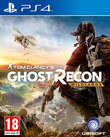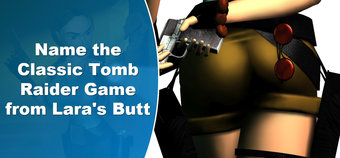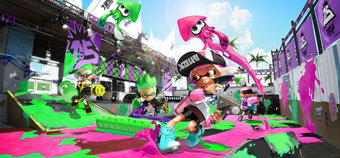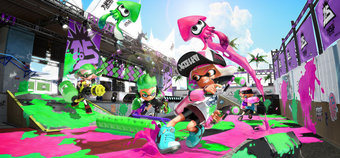There have been a lot of Tom Clancy games in recent years, across a lot of different genres. We've had real time strategy games (EndWar), flight sims (H.A.W.X), high tech stealth games (Splinter Cell), and tactical shooters, like Ghost Recon. Only this Ghost Recon is a little bit different. Seemingly seeing the success of Ubisoft's most recent Clancy outing, The Division, Ghsot Recon Wildlands treads a semi-similar path, becoming an open world game with an emphasis on co-op multiplayer fun.
Tom Clancy's Ghost Recon: Wildlands is set in a spectacular take on Bolivia, but one that's drastically different to the real thing. Having been taken over by the Santa Blanca cartel - a gang of ruthless drug pushers and crime lords, run by a guy called El Sueño, a big bad bald guy that's built like a brick wall, and is absolutely plastered with tattoos, including a holy cross on his face - Bolivia has become a drug riddled wasteland. With a populace kept in place through a mixture of ruthless murders, and some quasi-religious overtones, Santa Blanca have everything going their way, with all the fame, money, and power they could hope for - until they decide to murder a US drug enforcement agency operative. Having pushed the line that little too far, the yanks decide to respond, sending a special forces team in behind enemy lines, with instructions to break up the gang once and for all.

Well, that's at least one gang member down
Playable with up to four players in online co-op, or in single player with a crew of three computer controlled buddies in tow, Wildlands plays out rather differently to most of the Tom Clancy games that came before it. While both Tom Clancy and Ghost Recon are usually synonymous with stealth, there's really very little in the way of a real emphasis on truly staying hidden here - although as always, lurking in the shadows will certainly make your job a lot easier. Armed with only a handful of guns (mostly the ones you pick up off the baddies you kill), you don't even have access to a veritable treasure chest of gadgets, either, with your entire high tech arsenal consisting of some night vision goggles, a pair of binoculars, and a radio controlled drone that can barely get three feet from your head before it runs out of power.
Outmanned, and well outgunned, it falls to you to slowly dismantle the cartel piece by piece, in the same way as every other open world game since the beginning of time. By completing missions, you'll draw out sub-bosses, by killing the sub-bosses, you'll draw out regional bosses, and by killing them, you'll be able to make your way to a final showdown with the leader. So far, so standard - and to be honest, that's perhaps the biggest issue with Wildlands. While there's nothing all the wrong here, there's nothing all that new, or fresh either - it's just another open world game, with all the same things to see and do.

We will say this though - it doesn't half look nice in the rain
The structure, at least, is a little bit unusual. Rather than playing your way through a linear line of "main" missions, the game takes a much more free form approach. With a typically gigantic open world to explore, the game's divided into 21 regions, almost all of which have roughly half a dozen missions for you to test yourself against, in whichever order you see fit, as there's no real running order you're expected to play them in.
Instead, you'll first be asked to hunt down some intel, which in turn will unlock one of the region's missions for you to play. Usually marked on your map by way of a giant yellow folder, by collecting the intel (which may turn out to be a file, a laptop, a whiteboard, or something similar), you'll find yourself in possession of some important information about that area's leader, which in turn will unlock a mission. How you know where the intel is in order to have it marked on your map before you've even found it is anyone's guess - but as you may have guessed, Wildlands isn't exactly big on realism (not that that's a bad thing).
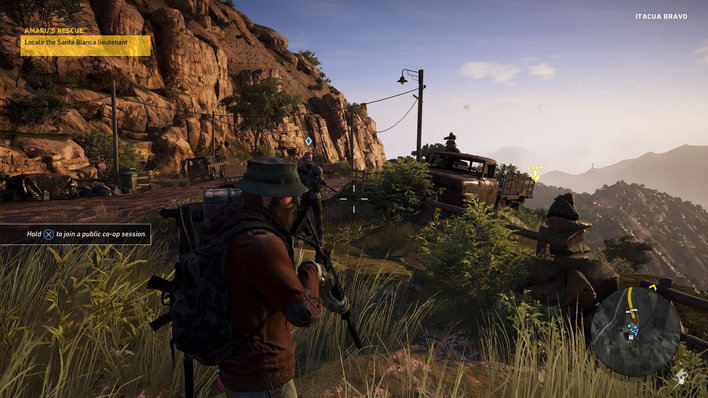
For reasons known only to itself, the game will KEEP prompting you to join a public co-oop session if you're playing on your own.
Once you've unlocked the mission, you can set yourself a waypoint for it on your world map, with the game giving you a handy "quickest route" line you can follow down roads to get there. As for the mission itself, the tasks you'll be given actually change depending on the region you're in, and the bad guy you're baiting, meaning there's a surprising amount of variety on offer here - even if most of them are rather short.
In Pan de Agua Verde, you'll be going after a chap called Carzita, who runs a number of luxury hotels and casinos, which both help keep the money coming in for the gang, and give them the perfect place to influence corrupt politicians. The missions here range from shooting up some one-armed bandits (the machines, not disabled Bolivians), to kicking up a fuss outside one of the luxury hotels (you know - by killing gangsters), or even using your drone to film a politician getting frisky with a prostitute (or to put it more crudely - talking). This latter mission is one of the few that actually does require stealth, as you'll need to get close to the heavily guarded hotel, before sending your drone off to film. Other missions in different areas see you ransacking prisons, kidnapping lieutenants, or stealing cars to check their GPS records, in the hope of hunting down their owner...

Using your binoculars to spot and tag enemies before you go in all guns blazing is a wise idea.
The problem is, the missions here generally come into two categories - the very quick, or the frustratingly hard. Many missions can be completed within a minute or two, as you blast your way in, get some important item/character, and blast your way out. Others require a more co-ordinated assault, as you slowly pick off enemies and work your way into a compound, which can be both more rewarding, and more frustrating. On the one hand, these missions feel more substantial, as they take a lot longer to complete - but on the other hand, the fact they take so much longer means the price for failure is so much higher. With no mid-mission checkpoints, you have to get in and out in one go - fail the mission, and you'll be back to the very start of the mission, with the game often placing you a kilometre away (and often nowhere near a road!) for good measure. Making matters worse is that some missions seem to have you fail for no reason, while others seem to be a little bit dodgy. The aforementioned shoot up outside a hotel sounds all well and good, but when moving less than 50 metres away from the door sees you start to time out of the mission - and with it being incredibly hard to tell where you actually need to be, if you're not on foot - it can be easy to find yourself dropped back to the very start of the mission, and having to start from scratch.

There's the hotel - and we're timing out!
Being killed doesn't always mean the end, though, as like many shooters, Wildlands lets your team mates revive you. The weird thing about Ghost Recon, though, is how it's different depending on whether you're playing online or not. Online, you and your friends can revive each other as much as you want (or need to), so long as you get to them within a 60 second time limit. In single player, though, you can only be brought back from the dead once per "combat". What the game classes as a combat encounter and what it doesn't is unclear, but it's more than a little bit odd to effectively try and make the offline harder than the online.
With a gigantic map to explore, you'd hope there'd be plenty of handy ways to get around the game's take on Bolivia, and you'd at least be half right. Perhaps most easily, if you've visited a location before, you can choose to fast travel there - but we all know that's nowhere near as much fun as exploring for yourself. Motorbikes and cars are the easiest (and most plentiful) ways to scour the landscape, and Ubisoft have actually done a really good job with them. Forget fragile, one-bump-and-you're-out vehicles - the cars in Wildlands are made of sturdier stuff. Not only can they take a pounding in terms of bullets (and crashes), but they're all also surprisingly good off road, able to climb steep hills, bounce over rocks, or barrel roll downhill (literally), before driving off as though nothing ever happened. Even better, if you're playing in multiplayer, one of your friends can jump in the boot of your car, only to lean out and start shooting should you find any baddies.
With the size of the game's world, though, just offering cars and bikes wouldn't really be enough - which is why Wildlands also has a number of choppers and planes scattered around the place, which you can use to take to the skies. The only problem is, the planes don't handle properly at all, having a tendency to fall out of the sky whilst doing the gentlest of turns, while for helicopters, the controls appear to be completely broken. Trying to make your helicopter fly in a straight line without veering all over the place, or suddenly losing or gaining height is nigh on impossible, which takes a lot of fun out of the game. Hovering over an enemy base with your friends blasting away from all angles should be a lot of fun, but instead you'll find you spend more time wrestling with the controls than you do wasting the enemy.
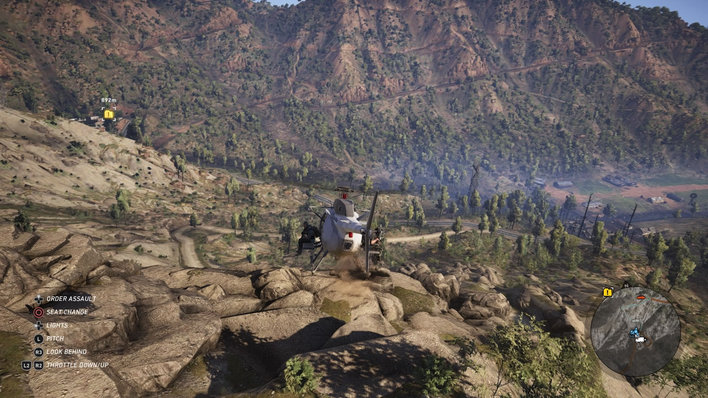
With so many cliffs around, you'd hope the flight controls might work a bit better...
In all, though, Wildlands is a fun, if unmemorable shooter that's certainly a lot better when played with friends. While there may be a few bugs, there's nothing spectacularly game breaking here - but there's nothing that'll make you want to slam your money on the counter either. While it's a solid co-op shooter, it's certainly a long way off the legendary co-op fun of something like the original Halo (especially as there's no split-screen), with bugs, and frustrating design decisions working against you just that once too many times. If you've got a group of friends to enjoy it with, you'll still have fun here - but if you're playing on your own, you've got a trickier choice on your hands.
Format Reviewed: Playstation 4


